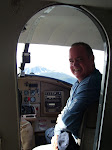 As I've written before, I get to work early. This morning, as the light was beginning to show in the sky, I had my doubts about flying. It had rained hard over night. The sky was still threatening with low clouds. I waited as late as I could before heading to the airport, expecting to get a call cancelling my lesson.
As I've written before, I get to work early. This morning, as the light was beginning to show in the sky, I had my doubts about flying. It had rained hard over night. The sky was still threatening with low clouds. I waited as late as I could before heading to the airport, expecting to get a call cancelling my lesson.Well, no one called, and as I drove north the weather got better. Not good, just better. Being a real novice at this flying thing, I don't know how bad is bad enough to cancel, but apparently today was not one of those days.
Rob beat me to the airport by a few minutes and had some coffee while I did the pre-flight inspection. We were in N54058 today. This is my favorite plane, it just seems easier to fly. Rob has me busy at this point, doing the pre-flight, running down the checklist and handling the radio.
"Whitted ground, Cessna 54058 at Bay air for departure to the west."
"54058, taxi to runway 7 and hold. Contact tower on 127.4"
"Taxi to 7 and hold, 54058"
A Piper Archer was on final and landed as we reached the hold line. Rob was telling me something about the radio when:
"Cessna 54058, are you ready to go?"
"Ready to go, 54058"
"54058, cleared for takeoff, left hand departure, I have another aircraft on downwind."
"Cleared for takeoff, left hand departure, 54058"
The controller was politely telling us that if we wanted to go it was now or wait for the other airplane to land, so off we went. Once airborne, I realized the weather was not as big a deal as I had imagined. The overcast sky kept the heating of the land down and no heating means no thermals and a smooth ride. Below the clouds, visibility was good. Actually, it was one of the nicest days I've had for flying.
Rob had me enter slow flight as soon as I reached altitude. It was pretty weird flying over St. Petersburg with the stall warning buzzing in my ear. I exited slow flight and practiced a power on and a power off stall. I'm getting more comfortable with those. After a couple of steep turns it was time for something new.
Emergency landing procedure. Glide Locate Identify Declare Execute, GLIDE. I believe there's a mnemonic device for everything in aviation. This one is pretty good. Glide, trim the airplane for a 65 knot descent without flaps. Locate, locate an emergency landing site. Identify, go over a brief checklist to see if you can identify the engine problem. Declare, get on the radio and let everyone know you have an emergency. Set your transponder to 7700, which will let Air Traffic Control know you are in trouble. Execute, execute the emergency landing.
That may seem like a lot, but once the plane is trimmed for the 65 knot descent, there is plenty of time for everything else. I lined up for an emergency landing on the beach at Egmont Key. Rob let me glide down to four or five hundred feet before telling me to recover. Full power and the plane climbs like a rocket. I enjoyed flying that low over Egmont Key. The beach has shifted a bit since I was a teenager. Parts of the old fort that I have climbed on and fished off of are now under water.
We practiced one more emergency landing then headed back to Albert Whitted. Rob said it was time for some touch and goes! Cool, I'm up for anything new.
"Whitted Tower, Cessna 54058 over the Don, inbound touch and go."
"54058, cleared for touch and go right hand pattern, straight in runway 7. You are number two in the pattern, I have a Piper on base."
"Touch and go, strait in runway 7. 54058"
Now, I've never done a touch and go before, so Rob explains it on our way it to land. The touch and go is easy, just apply power after you land, dump your flaps, steer with the feet and take off again. However, we were going to fly a right hand traffic pattern and go around for another landing. Today was better than my last two landings. I think I'm starting to get the feel of where I need to start my flare. Rob handled the flaps today as well as the radio calls while we were in the pattern. I had my hands full with the airplane. My left hand on the control yoke, my right hand on the throttle and my feet on the rudder pedals, so I was out of appendages and could not handle one more task. I'll be expected to do it all when I get more comfortable with the procedure. We went around and made two more landings before calling it a day.
Next lesson we will probably review more, try to start working on our ground reference maneuvers and do more pattern work. We also have some ground school work to do on airspace.
Statistics:
Dual Instruction Hours: 5.2
Landings: 7






No comments:
Post a Comment